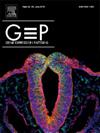Characterization of Hippo signaling components in the early dorsal pancreatic bud
IF 1.1
4区 生物学
Q4 DEVELOPMENTAL BIOLOGY
引用次数: 0
Abstract
All pancreatic lineages originate from a transitory structure known as the multipotent progenitor epithelium (MPE), which is an endodermal placode formed via epithelial stratification. Cells within the MPE undergo de novo lumenogenesis to give rise to an epithelial plexus, which serves as a progenitor niche for subsequent development of endocrine, ductal and acinar cell types. Recent evidence suggests that Hippo signaling is required for pancreatic cell differentiation, but little is known about the function of Hippo signaling in the development of the MPE. Here, we characterize the expression of YAP1, TAZ, and the Hippo regulators LATS1/2 kinases and MERLIN in early murine pancreatic epithelium, during epithelial stratification, plexus development and emergence of endocrine cells. We find that YAP1 expression is relatively low in the pancreas bud during stratification but increases by E11.5. Intriguingly, we find differing patterns of TAZ and YAP1 immunoreactivty throughout pancreatic development. We further find that MERLIN and LATS1/2 kinases are expressed during the period of rapid stratification and become markedly apical at nascent lumens. To gain a better understanding of how Hippo signaling and lumen formation are connected, we analyzed the subcellular localization of Hippo signaling components during varying stages of lumen formation and found that they are dynamically localized during lumenogenesis. Together, our results point to a previously unsuspected relationship between Hippo signaling and lumen formation during pancreatic development.
早期胰腺背芽中Hippo信号成分的表征。
所有胰腺谱系都起源于一种称为多能祖上皮(MPE)的暂时性结构,这是一种通过上皮分层形成的基板。MPE内的细胞经过新生的放光形成,形成上皮丛,作为内分泌、导管和腺泡细胞类型后续发育的祖生态位。最近的证据表明,Hippo信号是胰腺细胞分化所必需的,但对Hippo信号在MPE发育中的功能知之甚少。在这里,我们表征了YAP1、TAZ、Hippo调节因子LATS1/2激酶和MERLIN在早期小鼠胰腺上皮、上皮分层、神经丛发育和内分泌细胞出现期间的表达。我们发现YAP1在胰腺芽分层期间表达相对较低,但在E11.5时表达增加。有趣的是,我们发现TAZ而不是YAP1在早期内分泌细胞中表达。我们进一步发现,MERLIN和LATS1/2激酶在快速分层期间强烈表达,并在新生管腔中明显变为顶端。为了更好地了解Hippo信号与管腔形成之间的联系,我们分析了在管腔形成的不同阶段Hippo信号成分的表达,发现它们在管腔形成过程中是动态定位的。总之,我们的研究结果指出了胰腺发育过程中Hippo信号传导与管腔形成之间的关系。
本文章由计算机程序翻译,如有差异,请以英文原文为准。
求助全文
约1分钟内获得全文
求助全文
来源期刊

Gene Expression Patterns
生物-发育生物学
CiteScore
2.30
自引率
0.00%
发文量
42
审稿时长
35 days
期刊介绍:
Gene Expression Patterns is devoted to the rapid publication of high quality studies of gene expression in development. Studies using cell culture are also suitable if clearly relevant to development, e.g., analysis of key regulatory genes or of gene sets in the maintenance or differentiation of stem cells. Key areas of interest include:
-In-situ studies such as expression patterns of important or interesting genes at all levels, including transcription and protein expression
-Temporal studies of large gene sets during development
-Transgenic studies to study cell lineage in tissue formation
 求助内容:
求助内容: 应助结果提醒方式:
应助结果提醒方式:


